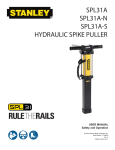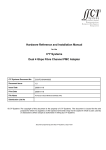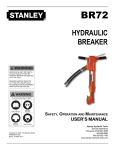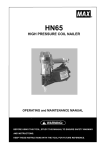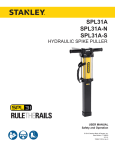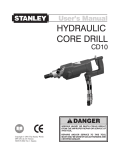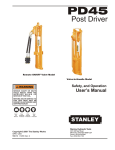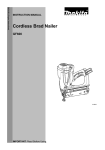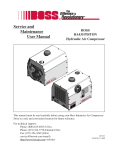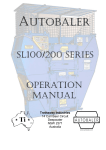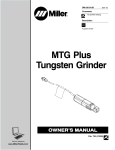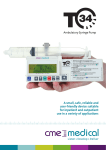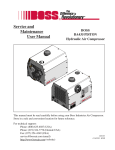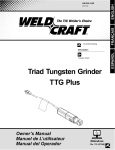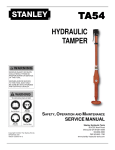Download DL09, 25077, 7-02
Transcript
® User’s Manual DL09 Hydraulic Drill This Manual Covers The Following Models: DL09150 DL09152S DL09152SN DL09152SUP DL09172S DL09172SN DL09550D DL0955001 DL09652 DL0965201 (Depth Rod Not Pictured) DANGER SERIOUS INJURY OR DEATH COULD RESULT FROM THE IMPROPER REPAIR OR SERVICE OF THIS TOOL. Copyright © 2002 The Stanley Works OPS USA & CE Version 25077 7/2002 Ver. 2 REPAIRS AND/OR SERVICE TO THIS TOOL MUST ONLY BE DONE BY AN AUTHORIZED AND CERTIFIED DEALER. Table of Contents DL09 Hydraulic Drill SERVICING THE DL09 HYDRAULIC DRILL: This manual contains Safety, Operation, and Troubleshooting information. Stanley Hydraulic Tools recommends that servicing of hydraulic tools, other than routine maintenance, must be performed by an authorized and certified dealer. Please read the DANGER warning on the cover and the SAFETY warning below. Copyright c 2002 The Stanley Works All rights reserved. Under copyright law, this document may not be copied in whole or in part without the prior written consent of The Stanley Works. This exception does not permit copies to be made for others, whether or not sold. Under the law, copying includes translating into another language, format or medium. This copyright notice must appear on any permitted copies. 2 Certificate of Conformity 3 Specifications 3 General Safety Instructions 4 Tool Decals and Tags 5 Hydraulic Hose Requirements 6 HTMA Requirements 7 Hydraulic Recommendations 8 Operating Instructions 9 Troubleshooting 11 Parts Illustration 13 Parts List 14 Warranty 16 SAFETY FIRST It is the responsibility of the operator and service technician to read rules and instructions for safe and proper operation and maintenance. A cautious worker using common sense is the greatest safety device. Certificate of Conformity I, the undersigned: Winterling, David Surname and First Names hereby certify that the construction plant or equipment specified hereunder: 1. Category: Drill 2. Make: Stanley DL0955001, & DL0965201 3. Type: 4. Type Serial Number of equipment: Stamped on tool 5. Year of manufacture: ALL Has been manufactured in conformity with- EEC Type examination as shown: Directive: Date: EN792-3 EN28662-1 EN ISO 3744 2001 6. Special Provisions: Done at: Approved body: Self Date of expiration: N/A None Stanley Hydraulic Tools, Milwaukie, Oregon USA Date: 2002 Position: Engineering Manager Signature: Specifications Drive Size______ 1/2 in./ 1.3 cm 3-Jaw Adjustable 5/8 - 16 THD Chuck Pressure Range______1000-2000 psi / 70-140 bar Flow Range_____________4-12 gpm / 15-45 lpm Optimum Flow________________ 8 gpm / 30 lpm System Type__open or closed center, HTMA TYPE I-III Porting_______________________-8 SAE O-ring Connect Size & Type___ 3/8 in. NPT Male Adapter Weight_______________________ 6 lbs. / 2.7 kg Overall Length__________________ 9 in. / 23 cm Width_______________________ 3-1/2 in. / 9 cm Motor____________________________ Integral Drill Torque___20 ft lbs / 27 Nm at 2000 psi/ 140 bar Drill Speed__________1000 rpm at 8 gpm/ 30 lpm RPM Range______________________350-1500 Max. Fluid Temp._____________ 140° F / 60° C HTMA Class II___________7-9 gpm @ 2000 psi 30Lpm at 138bar BHTMA CATEGORY EHTMA Category_____30 lpm @ 138 bar Weighted Vibration Level____________1.2(m/s2) Sound Pressure Level_Less than 85 dBA @ 1 m DL09 TORQUE AND DRILL SPEEDS TORQUE (proportional to Oil Pressure) Drill Speed (proportional to Oil Flow) HYDRAULIC FLOW DRILL SPEED USA METRIC 4 ft-lb @ 500 psi 9 ft-lb @ 1000 psi 14 ft-lb @ 1500 psi 19 ft-lb @ 2000 psi 5 Nm @ 35 bar 12 Nm @ 70 bar 19 Nm @ 105 bar 26 Nm @ 140 bar 3 gpm (11.3 lpm) 4 gpm (15 lpm) 6 gpm (23 lpm) 8 gpm (30 lpm) 10 gpm (38 lpm) 350 rpm 475 rpm 750 rpm 1000 rpm 1250 rpm 3 General Safety Instructions Always observe safety symbols. They are included for your safety and the protection of the tool. DANGER This safety symbol may appear on the tool. It is used to alert the operator of an action that could place him/her or others in a life threatening situation. WARNING This safety symbol appears in these instructions to identify an action that could cause bodily injury to the operator or other personnel. CAUTION This safety symbol appears in these instructions to identify an action or condition that could result in damage to the tool or other equipment. This tool will provide safe and dependable service if operated in accordance with the instructions given in this manual. Read and understand this manual and any stickers and tags attached to the tool and hoses before operation. Failure to do so could result in personal injury or equipment damage. A Operator must start in a work area without bystanders. The operator must be familiar with all prohibited work areas such as excessive slopes and dangerous terrain conditions. A Establish a training program for all operators to ensure safe operations. A Do not operate the tool unless thoroughly trained or under the supervision of an instructor. A Always wear safety equipment such as goggles, head protection, and safety shoes at all times when operating the tool. A Do not inspect or clean the tool while the hydraulic power source is connected. Accidental engagement of the tool can cause serious injury. A Do not operate this tool without first reading the Operating Instructions. A Do not install or remove this tool while the hydraulic power source is connected. Accidental engagement of the tool can cause serious injury. A Never operate the tool if you cannot be sure that underground utilities are not present. Underground electrical utilities present an electrocution hazard. Underground gas utilities present an explosion hazard. Other underground utilities may present other hazards. A Do not wear loose fitting clothing when operating the tool. Loose fitting clothing can get entangled with the tool and cause serious injury. A Supply hoses must have a minimum working pressure rating of 2500 psi/175 bar. A Be sure all hose connections are tight. A The hydraulic circuit control valve must be in the “OFF” position when coupling or uncoupling the tool. Wipe all couplers clean before connecting. Failure to do so may result in damage to the quick couplers and cause overheating. Use only lint-free cloths. A Do not operate the tool at oil temperatures above 140° F/60° C. Operation at higher oil temperatures can cause operator discomfort and may cause damage to the tool. A Do not operate a damaged, improperly adjusted, or incompletely assembled tool. A To avoid personal injury or equipment damage, all tool repair, maintenance and service must only be performed by authorized and properly trained personnel. A Do not exceed the rated limits of the tool or use the tool for applications beyond its design capacity. A Always keep critical tool markings, such as labels and warning stickers legible. A Always replace parts with replacement parts recommended by Stanley Hydraulic Tools. A Check fastener tightness often and before each use daily. A When working near electrical conductors, always assume that all conductors are energized and that insulation, Clothing and hoses can conduct electricity. Use hose labeled and certified as non-conductive. 4 Tool Decals & Tags A model sticker is attached to the tool. Never exceed the flow and pressure levels specified on this sticker. The information listed on the DL09 model sticker must be legible at all times. Replace this sticker if it becomes worn or damaged. A replacement is available from your local Stanley distributor. 28323 “CE” Decal (CE Models only) 29149 Rotation Direction Sticker (Not used on all models) 28788 Manual Sticker ® Model No. DL09 (Not used on all models) Stanley Hydraulic Tools 3810 SE Naef Rd Milwaukie, Oregon 97267 15-45 lpm/4-12 gpm 140 bar/2000 psi 28769 DL09 Model Sticker RPM Sticker 29148 (Not used on all models) 15211 Danger Sticker 30Lpm at 138bar BHTMA CATEGORY DANGER Failure to use hydraulic hose labeled and certified as non-conductive when using hydraulic tools on or near electric lines may result in death or serious injury. For proper and safe operation read owners manual and make sure that you have been properly trained in correct procedures required for work on or around ELECTROCUTION electric lines. HAZARD 7-10 GPM/ 24-36 LPM 11207 Circuit Type “D” Decal DO NOT EXCEED 2000 PSI/ 140 BAR n DO NOT EXCEED SPECIFIED FLOW OR PRESSURE. n USE CLOSED-CENTER TOOL ON CLOSED-CENTER SYSTEM. n USEOPEN-CENTER TOOL ON OPENCENTER SYSTEM. n CORRECTLY CONNECT HOSES TO TOOL "IN" AND "OUT" PORTS. n IMPROPER HANDLING, USE OR MAINTENANCE OF TOOL COULD RESULT INA LEAK, BURST OR OTHER TOOL FAILURE. n CONTACT AT A LEAK OR BURST CAN CAUSE OIL INJECTION INTO THE BODY. n FAILURE TO OBSERVE THESE PRECAUTIONS CAN RESULT IN SERIOUS PERSONAL INJURY. (Not used on all models) DANGER The SAFETY TAG, P/N 15875, shown at right, smaller than actual size, is attached to the tool when shipped from the factory. Read and understand the safety instructions listed on this tag before removal. We suggest you retain this tag and attach it to the tool when not in use. DANGER 1. FA I LU R E T O U S E H Y D RAU L I C H O S E L A B E L E D A N D CERTI-FIED AS NON-CONDUCTIVE WHEN USING HYDRAULIC TOOLS ON OR NEAR ELECTRICAL LINES MAY RESULT IN DEATH OR SERIOUS INJURY. BEFORE USING HOSE LABELED AND CERTIFIED AS NON- CONDUCTIVE ON OR NEAR ELECTRIC LINES. BE SURE THE HOSE IS MAINTAINED AS NON- CONDUCTIVE . THE HOSE SHOULD BE REGULARLY TESTED FOR ELECTRIC CURRENT LEAKAGE IN ACCORDANCE WITH YOUR SAFETY DEPARTMENT INSTRUCTIONS. 2. A H Y D R A U L I C L E A K O R B U R S T M AY C A U S E O I L INJECTION INTO THE BODY OR CAUSE OTHER SEVERE PERSONAL INJURY. A. D O N O T E X C E E D S P E C I F I E D F L O W A N D P R E S S U R E F O R T H I S T O O L . E X C E S S F LO W O R PRESSURE MAY CAUSE A LEAK OR BURST. B. D O N O T E X C E E D R AT E D W O R K I N G P R E S S U R E OF HYDRAULIC HOSE USED WITH THIS TOOL. E X C E S S P R E S S U R E M AY C A U S E A L E A K O R BURST. C. C H E C K T O O L , H O S E , C O U P L E R S & C O N N E C T O R S D A I LY F O R LEAKS. DO NOT FEEL FOR LEAKS WITH Y O U R H A N D S . C O N TA C T W I T H A L E A K M AY RESULT IN SEVERE PERSONAL INJURY. D. DO NOT LIFT OR CARRY TOOL BY THE HOSES. DO NOT ABUSE HOSE. DO NOT USE KINKED, TORN OR DAMAGED HOSES. 3. M A K E S U R E H Y D R A U L I C H O S E S A R E P R O P E R LY CONN-ECTED TO THE TOOL BEFORE PRESSURIZING S Y S T E M . S Y S T E M P R E S S U R E H O S E M U S T A LWAY S B E C O N N E C T E D T O T O O L “ I N ” P O R T. S Y S T E M R E T U R N H O S E M U S T A LW AY S B E C O N N E C T E D AT T O O L “ O U T ” P O RT. R E V E R S I N G C O N N E C T I O N S M AY C A U S E R E V E R S E T O O L O P E R AT I O N W H I C H C A N CAUSE SEVERE PERSONAL INJURY. 4. D O N O T C O N N E C T C L O S E D - C E N T E R T O O L S T O O P E N - C E N T E R H Y D R A U L I C S Y S T E M S . T H I S M AY C A U S E E X T R E M E S Y S T E M H E AT A N D / O R S E V E R E PERSONAL INJURY. DO NOT CONNECT OPEN-CENTER TOOLS TO C LO S E D - C E N T E R HYDRAULIC SYSTEMS. THIS MAY RESULT IN LOSS OF OTHER HYDRAULIC FUNCTIONS POWERED BY THE SAME SYSTEM AND/OR SEVERE PERSONAL INJURY. 5. B Y S TA N D E R S M A Y B E I N J U R E D I N Y O U R W O R K A R E A . K E E P BY S TA N D E R S C L E A R O F YO U R W O R K AREA. 6. WEAR HEARING, EYE, FOOT, HAND AND HEAD PROTECTION. 7. TO AVOID PERSONAL INJURY OR EQUIPMENT DAMAGE, ALL TOOL REPAIR, MAINTENANCE AND SERVICE MUST BE PERFORMED BY AUTHORIZED A N D P R O P E R LY TRAINED PERSONNEL. IMPORTANT IMPORTANT READ OPERATION MANUAL AND SAFETY INSTRUCTIONS FOR THIS TOOL BEFORE USING IT. READ OPERATION MANUAL AND SAFETY INSTRUCTIONS FOR THIS TOOL BEFORE USING IT. USE ONLY PARTS AND REPAIR PROCEDURES APPROVED BY STANLEY AND DESCRIBED IN THE OPERATION MANUAL. USE ONLY PARTS AND REPAIR PROCEDURES APPROVED BY STANLEY AND DESCRIBED IN THE OPERATION MANUAL. TAG TO BE REMOVED ONLY BY TOOL OPERATOR. (517) SEE OTHER SIDE 15875 TAG TO BE REMOVED ONLY BY TOOL OPERATOR. (517) SEE OTHER SIDE 15875 5 Hydraulic Hose Requirements HOSE TYPES Hydraulic hose types authorized for use with Stanley Hydraulic Tools are as follows: Certified non-conductive Wire-braided (conductive) Fabric-braided (not certified or labeled non-conductive) Hose listed above is the only hose authorized for use near electrical conductors. Hoses and listed above are conductive and must never be near electrical conductors. HOSE SAFETY TAGS To help ensure your safety, the following DANGER tags are attached to all hoses purchased from Stanley Hydraulic Tools. DO NOT REMOVE THESE TAGS. If the information in a tag is illegible because of wear or damage, replace the tag immediately. A new tag may be obtained at no charge from your Stanley Distributor. This Tag attached to “Certified Non-Conductive” hose. DANGER 1. FAILURE TO USE HYDRAULIC HOSE LABELED AND CERTIFIED AS NON-CONDUCTIVE WHEN USING HYDRAULIC TOOLS ON OR NEAR ELECTRIC LINES MAY RESULT IN DEATH OR SERIOUS INJURY. FOR PROPER AND SAFE OPERATION, MAKE SURE THAT YOU HAVE BEEN PROPERLY TRAINED IN CORRECT PROCEDURES REQUIRED FOR WORK ON OR AROUND ELECTRIC LINES. 2. BEFORE USING HYDRAULIC HOSE LABELED AND CERTIFIED AS NON-CONDUCTIVE ON OR NEAR ELECTRIC LINES, WIPE THE ENTIRE LENGTH OF THE HOSE AND FITTINGS WITH A CLEAN, DRY, ABSORBENT CLOTH TO REMOVE DIRT AND MOISTURE AND TEST HOSE FOR MAXIMUM ALLOWABLE CURRENT LEAKAGE IN ACCORDANCE WITH SAFETY DEPARTMENT INSTRUCTIONS. DANGER 4. HANDLE AND ROUTE HOSE CAREFULLY TO AVOID KINKING, ABRASION, CUTTING OR CONTACT WITH HIGH TEMPERATURE SURFACES. DO NOT USE IF KINKED. DO NOT USE HOSE TO PULL OR LIFT TOOLS, POWER UNITS, ETC. 5. CHECK ENTIRE HOSE FOR CUTS, CRACKS, LEAKS, ABRASIONS, BULGES OR DAMAGE TO COUPLINGS. IF ANY OF THESE CONDITIONS EXIST, REPLACE THE HOSE IMMEDIATELY. NEVER USE TAPE OR ANY DEVICE TO ATTEMPT TO MEND THE HOSE. 6. AFTER EACH USE, STORE IN A CLEAN, DRY AREA. 3. DO NOT EXCEED HOSE WORKING PRESSURE OR ABUSE HOSE. IMPROPER USE OR HANDLING OF HOSE COULD RESULT IN BURST OR OTHER HOSE FAILURE. KEEP HOSE AS FAR AWAY AS POSSIBLE FROM BODY AND DO NOT PERMIT DIRECT CONTACT DURING USE. CONTACT AT THE BURST CAN CAUSE BODILY INJECTION AND SEVERE PERSONAL INJURY. SEE OTHER SIDE SEE OTHER SIDE Side 1 Side 2 DO NOT REMOVE THIS TAG DO NOT REMOVE THIS TAG (shown smaller than actual size) p/n 27987 This Tag attached to “Conductive” hose. DANGER DANGER 1. DO NOT USE THIS HYDRAULIC HOSE ON OR NEAR ELECTRIC LINES. THIS HOSE IS NOT LABELED OR CERTIFIED AS NON-CONDUCTIVE. USING THIS HOSE ON OR NEAR ELECTRIC LINES MAY RESULT IN DEATH OR SERIOUS INJURY. 5. CHECK ENTIRE HOSE FOR CUTS, CRACKS, LEAKS, ABRASIONS, BULGES OR DAMAGE TO COUPLINGS. IF ANY OF THESE CONDITIONS EXIST, REPLACE THE HOSE IMMEDIATELY. NEVER USE TAPE OR ANY DEVICE TO ATTEMPT TO MEND THE HOSE. 2. FOR PROPER AND SAFE OPERATION, MAKE SURE THAT YOU HAVE BEEN PROPERLY TRAINED IN CORRECT PROCEDURES REQUIRED FOR WORK ON OR AROUND ELECTRIC LINES. 6. AFTER EACH USE, STORE IN A CLEAN, DRY AREA. 3. DO NOT EXCEED HOSE WORKING PRESSURE OR ABUSE HOSE. IMPROPER USE OR HANDLING OF HOSE COULD RESULT IN BURST OR OTHER HOSE FAILURE. KEEP HOSE AS FAR AWAY AS POSSIBLE FROM BODY AND DO NOT PERMIT CONTACT DURING USE. CONTACT AT THE BURST CAN CAUSE BODILY INJECTION AND SEVERE PERSONAL INJURY. 4. HANDLE AND ROUTE HOSE CAREFULLY TO AVOID KINKING, ABRASION, CUTTING OR CONTACT WITH HIGH TEMPERATURE SURFACES. DO NOT USE IF KINKED. DO NOT USE HOSE TO PULL OR LIFT TOOLS, POWER UNITS, ETC. SEE OTHER SIDE SEE OTHER SIDE Side 1 Side 2 DO NOT REMOVE THIS TAG DO NOT REMOVE THIS TAG (shown smaller than actual size) p/n 29144 HOSE PRESSURE RATING The rated working pressure of the hydraulic hose must be equal to or higher than the relief valve setting on the hydraulic system. 6 HTMA Requirements NOTE: These are general hydraulic system requirements. See tool specification page for tool specific requirements. Tool Category Hydraulic System Requirements Flow rate Tool Operating Pressure C 20Lpm at 138bar BHTMA CATEGORY 30Lpm at 138bar BHTMA CATEGORY Type I Type II 40Lpm at 138bar EHTMA CATEGORY Type III 4-6 gpm 7-9 gpm 10.5-11.6 gpm 11-13 gpm (at the power supply outlet) 2000 psi 2000 psi (138 bar) 2000 psi (138 bar) 2000 psi System relief valve setting 2100-2250 psi 2100-2250 psi 2100-2250 psi 2100-2250 psi Maximum back pressure 200 psi 200 psi 200 psi 200 psi (at the power supply outlet) (at tool end of the return hose) Measured at a max. fluid viscosity of: (at min. operating temperature) Temperature Sufficient heat rejection capacity to limit max. fluid temperature to: (15-23 lpm) (138 bar) (145-155 bar) (14 bar) 400 ssu* (26-34 lpm) (145-155 bar) (14 bar) (36-44 lpm) (145-155 bar) (14 bar) (42-49 lpm) (138 bar) (145-155 bar) (14 bar) (82 centistokes) (82 centistokes) 400 ssu* 400 ssu* 400 ssu* 140° F (60° C) 140° F (60° C) 140° F (60° C) 140° F (60° C) 3 hp (2.24 kW) 40° F (22° C) 5 hp (3.73 kW) 40° F (22° C) 6 hp (4.47 kW) 40° F (22° C) 7 hp (5.22 kW) 40° F (22° C) 25 microns 18 gpm (68 lpm) 25 microns 25 microns 25 microns 30 gpm (114 lpm) 35 gpm (132 lpm) 40 gpm (151 lpm) 100-400 ssu* 100-400 ssu* (82 centistokes) (82 centistokes) (at max. expected ambient temperature) Min. cooling capacity at a temperature difference of between ambient and fluid temps NOTE: Do not operate the tool at oil temperatures above 140° F (60° C). Operation at higher temperatures can cause operator discomfort at the tool. Filter Min. full-flow filtration Sized for flow of at least: (For cold temp. startup and max. dirt-holding capacity) Hydraulic fluid Petroleum based (premium grade, anti-wear, non-conductive) Viscosity (at min. and max. operating temps) NOTE: When choosing hydraulic fluid, the expected oil temperature extremes that will be experienced in service determine the most suitable temperature viscosity characteristics. Hydraulic fluids with a viscosity index over 140 will meet the requirements over a wide range of operating temperatures. * ssu = Saybolt Seconds Universal (20-82 centistokes) (20-82 centistokes) 100-400 ssu* (20-82 centistokes) 100-400 ssu* (20-82 centistokes) 7 Hydraulic Recommendations SPECIFICATIONS Fluids for Mobile Hydraulic Tool Circuits The specification listed here will provide good all season operation if your circuit is of proper design and normal maintenance is performed. (Periodic filter change, draining of condensate, etc. ITEM U.S.A. METRIC Viscosity (Fluid Thickness) 50° F 450 SSU Max 10° C 95 Centistokes Max. Viscosity (Fluid Thickness) 100° F 130-225 SSU 38° C 27-42 Centistokes Viscosity (Fluid Thickness) 140° F 85 SSE Min. 60° C 16.5 Centistokes Min. Pour Point (Min. for cold startup) -10° F 23° C Viscosity Index (ASTM D2220) 140 Minimum Demulsibility (ASTM D1401) 30 Minutes Max. Flash Point (ASTM D92) 340° F Min. Rust Inhibition (ASTM D665 A&B) Pass Oxidation (ASTM D943) 1000 Hours Min. Pump Wear Test (ASTM D2882) 60 mg Max. RECOMMENDED FLUIDS Recommended Fluids The fluids listed here work well over a wide temperature range at start-up, allow moisture to settle out, and resist biological growth likely in cool-operating hydraulic Circuits. These fluids are recommended by Stanley Hydraulic Tools for use in our tools. Other fluids that meet or exceed the specifications of these fluids may also be used. P/N 15596 04/98 .5M BRAND AMS-Oil BIODEGRADABLE DESCRIPTION No Hydraulic Fluid MN 150 SSU, 100 V.I. Chevron No AW-MV-32 Exxon No “Univis” J-26 Mobil No D.T.E. 13 Gulf No “Harmony” AW-HVI-1 50-32 Shell No “Lo-Hydraul” 32 Sun No “Sunvis” 805 MG Texaco No “Rando” HD-AZ Union No “Unax” AW-WR-32 Mobil Yes EAL 224H Texaco Yes BioStar 32 Terresole Yes EnviroLogic 132 Shell Yes Naturelle HF-E-32 Pennzoil Yes Pennzsafe Sl200 Operating Instructions CAUTION Make certain that the chuck has been securely mounted. Check Power Source 1. Using a calibrated flowmeter and pressure gauge during the intial set-up, check that the hydraulic power source develops a flow of 412 gpm/ 15-45 lpm at 1000-2000 psi/ 70-140 bar. 2. Make certain that the hydraulic power source is equipped with a relief valve set to open at 2100 psi/ 145 bar maximum. Connect Hoses 1. Wipe all hose couplers with a clean lint-free cloth before making connections. 2. Connect hoses from the hydraulic power supply to the tool quick disconnects. It is a good practice to connect the return hose first and disconnect it last to minimize or avoid trapped pressure within the drill. 3. Observe the arrow on hose couplers to ensure that the flow is in the proper direction. The male coupler on the circuit hose end is the supply (pressure) coupler. 4. Make sure the circuit PRESSURE hose (with male quick disconnect) is connected to the port at the back of the drill handle. The circuit RETURN hose (with female quick disconnect) is connected to the port closest to the trigger. 5. Move the hydraulic circuit control valve to the ON position to direct hydraulic flow to the drill. 9 NOTE: If uncoupled hoses are left in the sun, pressure increase inside the hose may result in making them difficult to connect. Whenever possible, connect the free ends of the hoses together. Drill Operation 1. Observe all safety precautions. 2. Place the selected drill bit fully into the chuck. Center the bit and tighten the chuck using the key provided. Remove the key and store away from the drill. 3. Momentarily press the trigger to ensure that the drill bit rotates clockwise and runs true. 4. Select a work position that gives secure footing and balance while operating the drill. 5. Press the drill against the work and squeeze the trigger. The drilling method used is determined by the material being drilled and the size and depth requirements of the hole. Ductile material such as metal or wood is drilled efficiently when a steady down force is applied to the drill center to cause the bit to slice chips of material from the hole bottom. When drilling in metal, use a cutting lubricant to prolong bit life and reduce the amount of force required to drill effectively. Large drill holes are more productively created from small drill holes. Drill bits are incrementally selected to enlarge the hole until the desired hole size is obtained. Each bit selected must always be too large to thread and jam into an existing hole; otherwise the bit may break and endanger the operator. Operating Instructions Cold Weather Operation Damage to the hydraulic system or tool can result from use with fluid that is too viscous or thick. If the tool is to be used during cold weather, preheat the hydraulic fluid at low engine speed. Follow steps 1 through 5 (connect hoses) page # 9 of the operating instructions. With the hoses connected to the power supply and to the tool, turn the circuit on (DO NOT OPERATE THE TOOL) and allow the hydraulic oil to preheat with the engine at low speed. Preheat the hydraulic fluid until the temperature is at or above 50° F/10° C (400 ssu/82 centistokes) when using the normally recommended fluids. Open Center/ Closed Center Setup (OC/CC) The adjustment for open center/ closed center is obtained by a flat screw slot located at front of tool. To adjust from OC to CC or vice ver-sa hold on to the trigger keeping it from being depressed. While using a flat screw driver push in and rotate the selector to the desired Open Center or Closed Center position (see illustration on this page). Note: Make sure that the four notches on the selector lock into the four cutouts in the trigger. For Closed Center operation turn the selector so that the slot is in the horizontal position (as shown in the illustration below). For Open Center operation rotate the selector until the slot is in the vertical position. 10 Troubleshooting This section describes how to find and resolve problems users may experience. If a situation occurs that is not covered, call your Stanley Customer Service representative for assistance. WARNING Inspecting the tool or installing parts with the hydraulic hoses connected can result in severe personal injury or equipment damage. To prevent accidental startup, disconnect the hydraulic power before beginning any inspection or installation task. If symptoms of poor performance develop, the following chart can be used as a guide to correct the problem. When diagnosing faults in operation of the tool, always check that the hydraulic power source is supplying the correct hydraulic flow and pressure to the tool as listed in the table. Use a flowmeter known to be accurate. Check the flow with the hydraulic oil temperature at least 80° F/27° C. Symptom Tool will not start. Possible Cause Power not being supplied. Defective quick disconnects. Low drilling torque. Solution Check to make certain that both hoses are connected. Turn hydraulic circuit control valve ON. Check each quick disconnect separately. Replace as necessary. Relief valve setting too low. Set relief valve at 2100 psi/ 145 bar. Fluid restriction in hose or valve. Excess flow and pressure loss. Locate and remove restriction. Use correct fluid. Fluid not warmed-up. Preheat system. Hoses too long for hose I.D. Use shorter hose. Hoses I.D. too small for hose length. Use larger I.D. hose. Low tool speed. Fluid flow rate is too low. Check circuit flow rate. Tool speed too high. Oil leaks around gear housing. Fluid flow rate is excessive. Check circuit flow rate; add a proper flow control valve. Correct hose connections. Pressure should be to the handle port away from the trigger, return is near the trigger, or see your Authorized Dealer for servicing. See your Authorized Dealer for servicing. Hydraulic pressure and return hoses reversed. Main shaft seal o-ring leaking. continued 11 Troubleshooting Symptom Oil gets hot, power unit working hard. Possible Cause Solution Open center tool on a closed center Use tools to match circuit. circuit and vice versa. Circuit relief set too low. Adjust relief valve to 2100 psi/ 145 bar. Too much oil going through tool. Adjust flow for 12 gpm/ 45 lpm maximum, or less. Oil leaks at reversing spool. Damaged o-rings. Replace as required. Wrong hydraulic fluid. Circuit too hot. See OPERATING INSTRUCTIONS for correct fluid/ circuit specifications. Oil leak at motor cap face. Fasteners loose. Tighten to specification (see service manual. Face o-ring worn or missing. See your Authorized Dealer. Motor cap/ main housing damaged. See your Authorized Dealer. 12 DL09 Parts Illustration 13 DL09 Parts List NOTE: Use Part Number and Description when ordering. Item Part 1 2 3 4 5 6 7 8 9 10 11 12 13 14 15 16 17 18 19 20 21 22 23 24 25 26 27 28 29 30 31 32 33 34 35 36 37 38 39 40 41 42 43 44 45 46 47 38676 38685 15211 08175 26655 24412 09623 09622 00753 09687 00111 09621 09778 09624 27628 08163 08162 00354 08165 09779 08161 08440 08166 06635 20767 13995 18206 00146 26297 00231 00145 20770 01262 24271 05207 00713 27559 20790 20758 00026 20782 20760 20769 28769 28323 28788 28316 29149 20781 01605 06617 29313 24161 23175 23174 20783 02178 Description Depth Guage Rod (ModelsDL09172S,DL09172SN, & DL09152S Only)Shipped uninstalled. Thumb Screw (ModelsDL09172S,DL09172SN, & DL09152S Only)Shipped uninstalled. Danger Sticker (Not used on Models DL0955001 & DL0965201) Ball Bearing Gear Housing Gear Housing (Model DL09150 ONLY) Lockwasher # 10 Capscrew 10-24x1-1/4 HSH Stainless Capscrew 10-24x1-1/4 HSH (Model DL09150 ONLY) Capscrew 10-24x2 HSH Stainless Capscrew 10-24x1-1/2 Hex Socket head (Model DL09150 ONLY) Shaft Seal Seal Nut Chuck 3 Jaw Adjustable, 5/8-16 THD (All Models Except DL09172S & DL09172SN) Chuck 3 Jaw Adjustable, 5/8-16 THD (Used on Models DL09172S & DL09172SN only) Bearing Keeper Shaft Keeper O-ring 1/2 x 11/16 x 3/32 - 112 Planet Gear Assembly Output Shaft Planet Shaft Retaining Ring Ring Gear Retaining Ring Seal Back-up Washer Back-up Ring - 112 Capscrew 5/16-18x1-3/4 HSH STNLS Capscrew 5/16-18x1-3/4 HEX SOC HEAD (Model DL09150 ONLY) Capscrew 5/16-18x1-3/4 ZNC PLT (Model DL09152SN ONLY) Lockwasher 5/16 High Collar Lockwasher 5/16 High Collar (Model DL09150 ONLY) Motor Cap Assy (Includes Items 28 & 29) O-ring 1-3/4 x 1-7/8 x 1/16 - 031 Main Shaft Bushing Dowel Pin Main Housing Assy (Includes Items 28,31,32) Main Housing Assy (Models DL09550D, DL09150, & DL0955001 ONLY) (Includes Items 28, 31,32) Bushing O-ring Idler Shaft Bushing Idler Gear Assy (Includes Item 34) DL09 Model Number Sticker CE Sticker (Models DL0955001 & DL0965201 ONLY) Manual Sticker (Models DL0965201 & DL0955001 ONLY) CN Sticker (Model DL09152SN ONLY) Rotation Direction Sticker (Models DL0955001 & DL0965201 ONLY) Spring Cap O-ring 1/2 x 5/8 x 1/16 - 014 Spring Valve Spool Assy-OC/CC Valve Spool-OC (Model DL09150 ONLY) Capscrew 12-24x3/8 Hex Soc Flat Head Capscrew 12-24x3/8 Hex Soc Flat Head (Models DL09150, DL09550D, & DL0955001 ONLY) Stop Washer Wiper Seal Qty. 1 1 1 1 1 1 3 3 3 3 2 1 1 1 1 1 1 2 2 1 2 1 1 1 1 1 6 6 6 6 6 1 1 1 2 2 1 1 1 2 1 1 1 1 1 1 1 1 1 1 1 1 1 2 2 2 2 14 DL09 Parts List (Continued) NOTE: Use Part Number and Description when ordering. Item Part 48 49 50 51 52 53 54 55 56 57 58 Description 61 62 63 20786 01604 00106 34893 12100 03709 08130 18919 14019 14028 14024 24411 14022 07724 06971 00936 28234 24058 64 03972 24059 65 66 67 68 03973 06345 12621 07970 11207 Seal Cap O-ring .755x.949x.097 -012 R16 O-ring 3/8x1/2x1/16 -012 R16 Reversing Spool Steel Ball 3/8 Dia. (Not Used on Model DL09150) SAE Plug -5 Hex Soc Head Cross Handle (Not Used On Models DL09150, DL09550D, & DL0955001) Pin To Socket Adaptor (Not Used On Model DL09150) Spool End Socket (Not Used On Model DL09150) Retaining Ring Trigger Trigger (Model DL09150 ONLY) Trigger Guard (Not Used On Model DL09150) Locknut 10-24 STNLS Locknut 10-24 (Used On Model DL09152SN ONLY) Adaptor Fitting (Used On Models DL09150, DL0955001, & DL09550D ONLY) Hose Whip (Not Used On Models DL09150, DL0955001, & DL09550D) Female Coupler Body 3/8”(Not Used On Models DL09150, DL09550D, DL09652 & DL0955001) Female Coupler Body (Used On Model DL0955001 ONLY) Male Coupler Body 3/8”(Not Used On Models DL09150, DL09550D, DL09652, & DL0955001) Male Coupler Body (Used On Model DL0955001 ONLY) Plastic Plug ( Not Illustrated) Seal Gasket Spirol Pin 3/16x1-3/8 Circuit Type “D” Decal ---------- 26299 11191 29456 Lockout Kit (shipped unassembled) Not Used On Model DL09150 Chuck Key used on 3/8 chuck (All Models except DL09172S & DL09172SN) Chuck Key used on ½ chuck (Used on models DL09172S & DL09172SN ONLY) 59 60 Qty. 2 2 4 1 2 2 1 1 1 1 1 1 1 1 1 2 2 1 1 1 1 1 1 1 2 1 1 1 A Supplied with Item # 53 Seal Kit P/N 25078 00026 00106 00354 00717 01262 01604 01605 02003 02178 03364 08928 09621 13995 12621 25079 O-ring 3/16 x 5/16 x 1/16 - 008 O-ring 3/8 x 1/2 x 1/16 - 012 O-ring ½ x 11/16 x 3/32 - 112 O-ring 2-112 R16 O-ring 1-3/4 x 1-7/8 x 1/16 - 031 O-ring .755 x .949 x .097 -910 O-ring 1/2x5/8x1/16-014 O-ring 2-113 R16 Wiper Seal 3/8 x 5/8 x 1/8 O-ring 3-905 R17 Back-up Ring Shaft Seal Back-up Ring - 112 Seal Gasket INST. For seal kit 2 4 2 1 1 2 1 1 2 2 1 1 1 1 1 Note: No Male or Female Couplers are Provided with Models DL09150, DL09652, & DL09550D. 15 Warranty Stanley Hydraulic Tools (hereinafter called “Stanley”), subject to the exceptions contained below, warrants new hydraulic tools for a period of one year from the date of sale to the first retail purchaser, or for a period of 2 years from the shipping date from Stanley, whichever period expires first, to be free of defects in material and/or workmanship at the time of delivery, and will, at its option, repair or replace any tool or part of a tool, or new part, which is found upon examination by a Stanley authorized service outlet or by Stanley’s factory in Milwaukie, Oregon to be DEFECTIVE IN MATERIAL AND/OR WORKMANSHIP. EXCEPTIONS FROM WARRANTY NEW PARTS: New parts which are obtained individually are warranted, subject to the exceptions herein, to be free of defects in material and/or workmanship at the time of delivery and for a period of 6 months after the date of first usage. Seals and diaphragms are warranted to be free of defects in material and/or workmanship at the time of delivery and for a period of 6 months after the date of first usage or 2 years after the date of delivery, whichever period expires first. Warranty for new parts is limited to replacement of defective parts only. Labor is not covered. FREIGHT COSTS: Freight costs to return parts to Stanley, if requested by Stanley for the purpose of evaluating a warranty claim for warranty credit, are covered under this policy if the claimed part or parts are approved for warranty credit. Freight costs for any part or parts which are not approved for warranty credit will be the responsibility of the individual. SEALS & DIAPHRAGMS: Seals and diaphragms installed in new tools are warranted to be free of defects in material and/or workmanship for a period of 6 months after the date of first usage, or for a period of 2 years from the shipping date from Stanley, whichever period expires first. CUTTING ACCESSORIES: Cutting accessories such as breaker tool bits are warranted to be free of defects in material and or workmanship at the time of delivery only. ITEMS PRODUCED BY OTHER MANUFACTURERS: Components which are not manufactured by Stanley and are warranted by their respective manufacturers. a. Costs incurred to remove a Stanley manufactured component in order to service an item manufactured by other manufacturers. ALTERATIONS & MODIFICATIONS: Alterations or modifications to any tool or part. All obligations under this warranty shall be terminated if the new tool or part is altered or modified in any way. NORMAL WEAR: Any failure or performance deficiency attributable to normal wear and tear such as tool bushings, retaining pins, wear plates, bumpers, retaining rings and plugs, rubber bushings, recoil springs, etc. INCIDENTAL/CONSEQUENTIAL DAMAGES: To the fullest extent permitted by applicable law, in no event will STANLEY be liable for any incidental, consequential or special damages and/or expenses. FREIGHT DAMAGE: Damage caused by improper storage or freight handling. LOSS TIME: Loss of operating time to the user while the tool(s) is out of service. IMPROPER OPERATION: Any failure or performance deficiency attributable to a failure to follow the guidelines and/or procedures as outlined in the tool’s operation and maintenance manual. MAINTENANCE: Any failure or performance deficiency attributable to not maintaining the tool(s) in good operating condition as outlined in the Operation and Maintenance Manual. HYDRAULIC PRESSURE & FLOW, HEAT, TYPE OF FLUID: Any failure or performance deficiency attributable to excess hydraulic pressure, excess hydraulic back-pressure, excess hydraulic flow, excessive heat, or incorrect hydraulic fluid. REPAIRS OR ALTERATIONS: Any failure or performance deficiency attributable to repairs by anyone which in Stanley’s sole judgement caused or contributed to the failure or deficiency. MIS-APPLICATION: Any failure or performance deficiency attributable to mis-application. “Mis-application” is defined as usage of products for which they were not originally intended or usage of products in such a matter which exposes them to abuse or accident, without first obtaining the written consent of Stanley. PERMISSION TO APPLY ANY PRODUCT FOR WHICH IT WAS NOT ORIGINALLY INTENDED CAN ONLY BE OBTAINED FROM STANLEY ENGINEERING. WARRANTY REGISTRATION: STANLEY ASSUMES NO LIABILITY FOR WARRANTY CLAIMS SUBMITTED FOR WHICH NO TOOL REGISTRATION IS ON RECORD. In the event a warranty claim is submitted and no tool registration is on record, no warranty credit will be issued without first receiving documentation which proves the sale of the tool or the tools’ first date of usage. The term “DOCUMENTATION” as used in this paragraph is defined as a bill of sale, or letter of intent from the first retail customer. A WARRANTY REGISTRATION FORM THAT IS NOT ALSO ON RECORD WITH STANLEY WILL NOT BE ACCEPTED AS “DOCUMENTATION”. NO ADDITIONAL WARRANTIES OR REPRESENTATIONS This limited warranty and the obligation of Stanley thereunder is in lieu of all other warranties, expressed or implied including merchantability or 16 For additional Sales & Service information, contact: ® Stanley Hydraulic Tools Division of the Stanley Works 3810 SE Naef Road Milwaukie, OR 97267 USA Tel: (503) 659-5660 Fax: (503) 652-1780


















